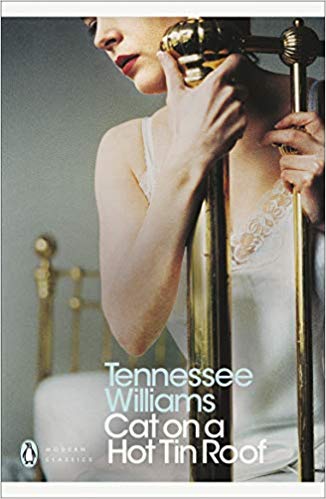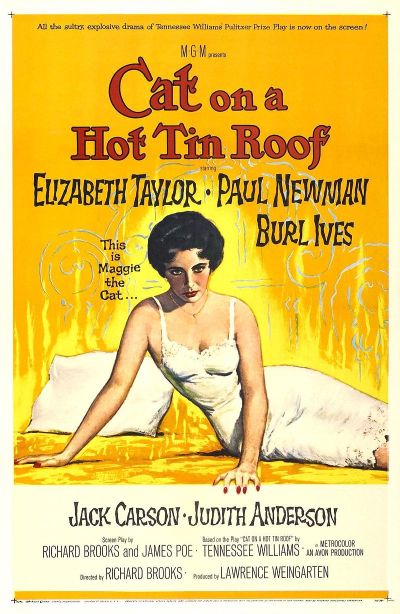Cat on a Hot Tin Roof by Tennessee Williams
Review by Rose
 If the dialogue in Tennessee Williams masterful ‘Cat on a Hot Tin Roof’ became music, it would be a frantic drumbeat; an Avant-Garde jazz piece blistering with energy and a tempestuous screeching saxophone, echoing the burning intensity of this dysfunctional family’s emotions. This is a dynamic play that sizzles and electrifies with an undercurrent of rage and repressed sexual desire. Williams is a maestro of dramatic discourse, engineering conversations to generate maximum tension. In the smouldering heat of Mississippi, Maggie’s sexual frustration becomes a spirited cry that moves rapidly through the rooms of the mansion, like the fiercest wind, affecting everyone in its path. Her conversations become cruel and her personality transforms, as her body’s biological needs push her into a frenzy of desperate behaviours. Maggie’s desire becomes a phenomenal force that has as much supremacy and magnitude as death itself. Death towers above the family, its presence and power entering the minds of all characters. It waits patiently for the last gasps of Big Daddy. Big Daddy, the patriarch, desperately holds onto life, like a man grasping at a sinking boat laden with rocks, unable to relinquish his control and wealth.
If the dialogue in Tennessee Williams masterful ‘Cat on a Hot Tin Roof’ became music, it would be a frantic drumbeat; an Avant-Garde jazz piece blistering with energy and a tempestuous screeching saxophone, echoing the burning intensity of this dysfunctional family’s emotions. This is a dynamic play that sizzles and electrifies with an undercurrent of rage and repressed sexual desire. Williams is a maestro of dramatic discourse, engineering conversations to generate maximum tension. In the smouldering heat of Mississippi, Maggie’s sexual frustration becomes a spirited cry that moves rapidly through the rooms of the mansion, like the fiercest wind, affecting everyone in its path. Her conversations become cruel and her personality transforms, as her body’s biological needs push her into a frenzy of desperate behaviours. Maggie’s desire becomes a phenomenal force that has as much supremacy and magnitude as death itself. Death towers above the family, its presence and power entering the minds of all characters. It waits patiently for the last gasps of Big Daddy. Big Daddy, the patriarch, desperately holds onto life, like a man grasping at a sinking boat laden with rocks, unable to relinquish his control and wealth.
The eldest son, Gooper, and his wife savagely fight their in-laws: the younger son, Brick (an alcoholic) and his wife Maggie, for the inheritance of the plantation. Brick, stands detached from the tornado of human emotions encircling him. He is a man that keeps a distance from those around him. Brick is skilled at hiding his feelings and his life, he evades personal questions. He drinks because he blames himself for his friends’ suicide. He hates himself because he is sexually attracted to men and does not want to admit his attraction, even to himself. What is the effect of biological cravings? How do wealth and greed change a human being? What is the effect of death on a dysfunctional family? William’s explores these and many other complex themes.
The most prominent questions in the play are: Why do people lie to themselves? Why would a person live a lie? And does one even have a choice? In some cases, decisions may be governed by societies rules and attitudes of the time. Despite being dated in some of its representations, and the vast changes in women’s roles and societies attitudes towards homosexuality and bisexuality in the modern age. Cat on a hot tin roof has magnetism and vivacity that has withstood the decades, and still thrills, demonstrating the genius of a playwright who strove to write about male-to-male attraction at a time when many men had to hide their feelings.
Big Daddy, the wealthy plantation owner, and head of the family is dying. He expresses his fear of death in conversations that are constructed through deep terror, as he makes a last attempt to connect with his Brick. William’s understands the chaos and dread that death can bring to the household. He tells his son Brick, that wealthy men with power never want to die. Mortality is one of the major themes in a ‘Cat on a Hot Tin Roof’, not just mortality, but the effect of death in the minds and motivations of all the other characters in the play. It's big Daddy's death that creates the savagery of his older son Gooper and his wife as they battle for the plantation.
Brick is an ex-athlete who had an accident while drunk, he now struggles around the mansion with crutches while the injury heals. He drinks till he feels that relieving ‘click’ in his brain, the moment when all the pain of his life and self-torment is erased. Brick is emotionally traumatised, and unable to act or make decisions, as he is suffering with a deep depression. His closest friend, Skipper, committed suicide, and Brick blames himself as he did not take the call the night Skipper died. He also hates himself as he is attracted to men. During the play, he makes homophobic slurs, desperately attempting to deny that he is sexually attracted to men. It may be that the character’s negative reactions towards gay men stem from his upbringing and societies attitudes of the time. It may be also fear that makes him deny his real feelings. For many decades it’s been debated whether Brick was gay or bi-sexual, in a recent production of ‘Cat on a Hot Tin Roof’ in America, Brick is played as Bi-Sexual. He is attracted to both women and men.
 In the time that Williams created the play, the 1950’s, many gay actors hid the fact that they were gay, as it would have ruined their careers and lives. These actors were often forced to live a lie in order to attain acting roles in the industry. Some married, while discreetly seeing men, others like Tennessee Williams, lived a more openly gay lifestyle. Living a lie, was something that Williams would have understood.
In the time that Williams created the play, the 1950’s, many gay actors hid the fact that they were gay, as it would have ruined their careers and lives. These actors were often forced to live a lie in order to attain acting roles in the industry. Some married, while discreetly seeing men, others like Tennessee Williams, lived a more openly gay lifestyle. Living a lie, was something that Williams would have understood.
In society, in the fifties, gays were stigmatised and labelled as ‘mentally ill’. It took decades of activism, cultural changes and transformations in attitudes in society, to fight the way gay men were categorised in the Diagnostic and Statistical Manual of Mental Health Disorders (DSM). The first descriptions and categorisation in the DSM were shocking. It also took many long years to change the law about homosexuality. In the UK this change did not happen until the late 1960’s.
Williams writing plays like ‘Cat on a Hot Tin Roof’ and ‘Suddenly Last Summer’ in the 1950’s was risky. Yet, he carried on, and by doing so, took plays to the stage and into theatre, creating debate in the public domain.
It’s a testament to William’s, that he was writing plays where sexual attraction to men was discussed and addressed even if his writing had to be repressed. Nevertheless, in Hollywood, you were not allowed to show openly gay relationships on screen, and attractions to men were usually watered down, or shown in a damaging way. The film version of Kazan’s ‘Cat on a Hot Tin Roof’ had a change in ending requested by the director. There are two endings to ‘Cat on a Hot Tin Roof’, you can read both endings in some copies of the play. Kazan’s film production was masterful with wonderful performances by Paul Newman and Elizabeth Taylor, however, the subject of male sexual attraction was watered down to fit into the industries expectations.
If one analyses gender roles in the play, one can also see that the changing roles of women in households has progressed greatly since the 1950’s, with women working outside the home, and no longer being forced into the role of simple ‘housewife.’
Maggie is deeply in love with Brick and though he’s told her take a lover she refuses. Not having sex and being refused sex as a healthy young female, begins to affect her personality and life. Biology affecting the personality and mind of a person and repressed desire is another major theme of the play. Her sexual frustration is a driver in this play, just as Brick’s inability to face the truth about himself and his attraction to men, is also a driving force of the play.
Williams analyses why someone would lie to themselves and live a lie. In the middle of both of their emotional trauma’s Big Daddy’s death and mortality are powerful symbols, just like the marital bed, a place that appears cold and devoid of passion. Other themes are capitalism and greed. The way Gooper and his wife fight for the wealth of big Daddy shows an unpleasant side to human nature and one that the character Brick finds repulsive. There are many arguments in the play and power relations and the changing power in relationships is carefully crafted by Williams. EVery conversation is an attempt for one character to create control and dominence over another.
In the play everyone carries the weight of their guilt, greed, fear around with them. Williams skill at dialogue and creating forceful scenes, conversations charged with emotion. He has created a play that despite being over fifty years old, holds a great place in the history of playwriting. Cat on a Hot Tin Roof has not been the most popular plays of Williams in the theatre, yet it should have been.